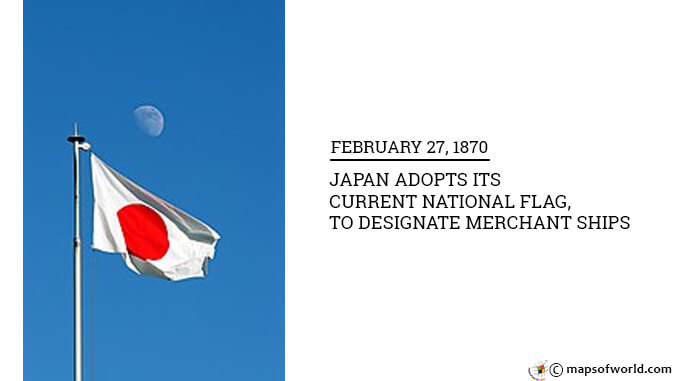The national flag of Japan, officially known as the Nisshoki or the Sun–mark flag was adopted on February 27, 1870. At the time, however, it was meant to be the flag to identify the Japanese nationality of the merchant ships and not the flag that represents the nation itself. Japan’s association with the Hinomaru or the Sun Disc is a very ancient one. Japan is called “the land of the rising sun”, perhaps due to its location in the Far East. Not surprisingly, the Imperial family of Japan is believed to have descended from Amaterasu, the sun goddess. The Hinomaru motif seems to have been associated with the country’s regent even as far back as the 7th century. Various forms of the sun disc were carried by samurais in the 12th century. In the next century, Nichiren Daishonin, the Buddhist monk who lived during the Kamakura period and is the famed teacher of the Lotus Sutra, is believed to have presented the ensign to a shogun. In the 16th century, each Daimyo feudal lord fashioned out his own ensign to be carried into battle. By the 19th century, during the dominance of the Tokugawa shogunate, it was decreed that a unification of some sort is necessary, especially to identify Japanese ships at sea. By order of the Proclamation No. 57 of Meiji 3, dated February 27, 1870, it became mandatory for Japanese merchant ships to fly the Hinomaru ensign for easy identification. Later, on October 27, 1870, Proclamation No. 651 of Meiji 3 directed the Japanese Imperial Navy to use the flag as its standard banner as well. The period of the Meiji Restoration between the second half of the 19th and the early 20th centuries, was a period for revolutionary modernization in Japan. The end of the shogunate and the beginning of associations and collaborations with the west made it necessary for the nation to have a flag that would represent it. The sun disc became the de facto flag of the country. During the Sino-Japanese Wars and the Russo-Japanese Wars, the Hinomaru became a rallying point for patriotism and Japanese nationalism. For the outside world, the flag became a symbol of the Japanese military and its extremely disciplined mobilization. During the World War II, the Hinomaru came to represent Japan’s territorial ambitions. Following World War II, during the occupation of Japan by the Allied forces, the use of the Hinomaru ensign faced severe restrictions, though no outright ban was imposed. Japanese nationals and communities required the permission of the Supreme Commander of the Allied Powers to hoist and fly the flag. These restrictions were initially lifted in May 1947 with the ratification of the current Constitution of Japan. By 1950, these restrictions were wholly done away with. In 1964, a few modifications were made to the Hinomaru flag to make the sun prominent. Till the 1990s, though the Sun Disc flag was the de facto ensign of Japan, the flag had no legal sanction. In 1999, a seemingly inconsequential standoff between the school board and teachers of Sera High School in Sera, Hiroshima, over the use of the flag and the Kimigayo ode (now the national anthem of Japan), led to the suicide of the school’s principal, Ishikawa Toshihiro. The incident attracted national attention and led to the passage of the Act on National Flag and Anthem which was ratified on August 13, 1999. Thus, what started as a banner meant to distinguish merchant ships completed a long journey to become the national flag of Japan. The Japanese flag is a white field with a red sun-disc in its center. According to protocol, the military flags are to be made of acrylic fiber or nylon fiber. The red color used on acrylic fiber is 5.7R 3.7/15.5 and white is N9.4 while on nylon fiber the red is 6.2R 4/15.2 and white is N9.2. You may also like : February 27 1940 – Carbon-14 is Discovered by Martin Kamen and Samuel Ruben
February 27 1870 – Japan adopts its current national flag, to designate merchant ships
The national flag of Japan, officially known as the Nisshoki or the Sun–mark flag was adopted on February 27, 1870. At the time, however, it was meant to be the…
317
